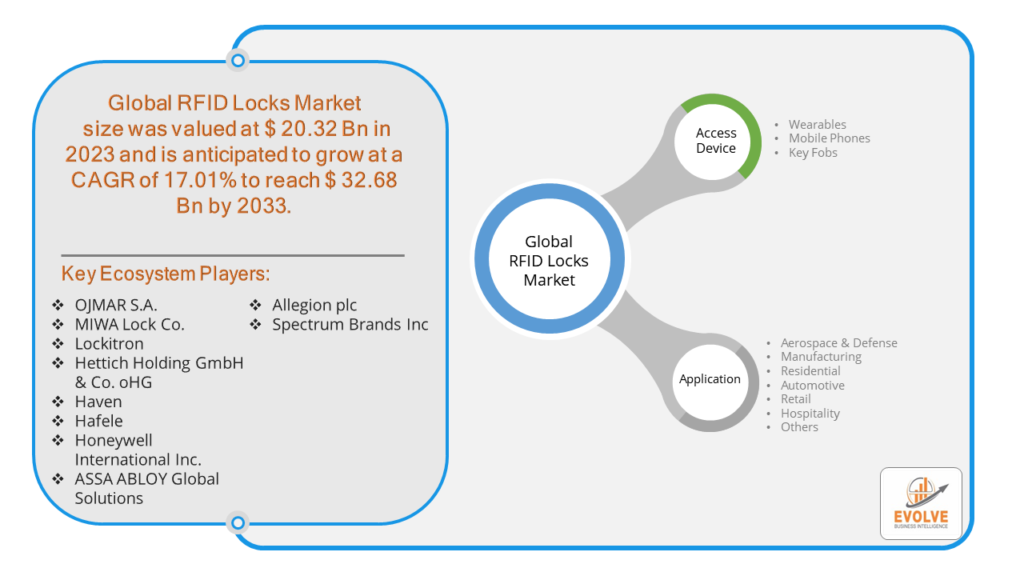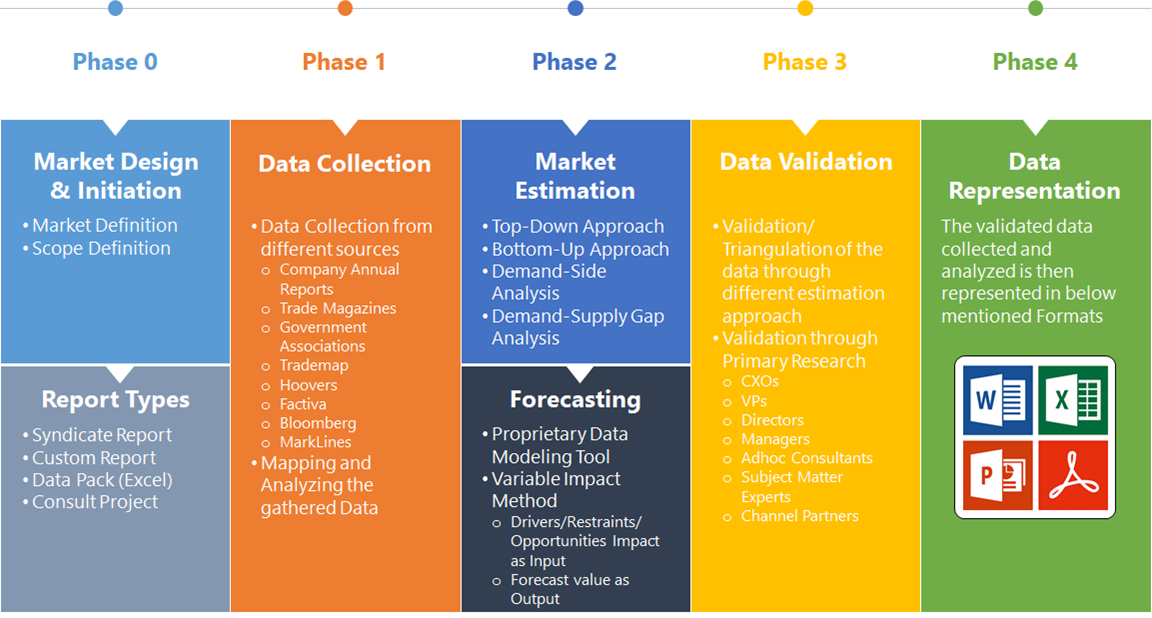RFID Locks Market Overview
The RFID Locks Market Size is expected to reach USD 32.68 Billion by 2033. The RFID Locks Market industry size accounted for USD 20.32 Billion in 2023 and is expected to expand at a compound annual growth rate (CAGR) of 17.01% from 2023 to 2033. RFID (Radio Frequency Identification) locks refer to electronic locking systems that utilize RFID technology for access control. These locks operate by using RFID tags or cards that communicate wirelessly with the lock’s reader. The RFID Locks Market encompasses the manufacturing, distribution, and adoption of such locks across various sectors, including residential, commercial, and industrial applications.
Key drivers in this market include increasing security concerns, convenience in access control management, and advancements in RFID technology enhancing reliability and functionality.
Global RFID Locks Market Synopsis
The COVID-19 pandemic had mixed impacts on the RFID Locks Market. Initially, there was a slowdown in manufacturing and supply chain disruptions due to lockdowns and restrictions on movement. However, as businesses and organizations adapted to new health protocols, there was an increased focus on contactless technologies like RFID locks. This shift was driven by the need for touch-free access control solutions to minimize physical contact and enhance hygiene standards. As a result, there was a growing demand for RFID locks in sectors such as healthcare facilities, offices, and residential buildings. Overall, the pandemic accelerated the adoption of RFID locks, albeit with temporary disruptions in supply chains and manufacturing capabilities.
RFID Locks Market Dynamics
The major factors that have impacted the growth of RFID Locks Market are as follows:
Drivers:
Ø Security Enhancement
RFID locks provide robust security features compared to traditional locks, including encrypted communication and authentication protocols, which appeal to sectors needing stringent access control. The increasing emphasis on hygiene and minimizing physical contact due to events like the COVID-19 pandemic has boosted demand for contactless access solutions like RFID locks. RFID locks can integrate with IoT (Internet of Things) platforms and smart building systems, enabling advanced functionalities such as remote monitoring, real-time access logs, and integration with other security systems. Continuous advancements in RFID technology, including improved range, reliability, and battery life of RFID devices, contribute to the growth and adoption of RFID locks in various applications.
Restraint:
- Perception of Cost Considerations
While RFID technology has become more affordable over time, initial deployment costs for RFID locks can still be higher compared to traditional mechanical locks. This upfront cost can be a barrier, especially for smaller businesses or residential applications with limited budgets. Integration of RFID locks with existing infrastructure and systems can sometimes be challenging, particularly in older buildings or environments where retrofitting is required. Compatibility issues may arise with older access control systems or network infrastructures, leading to additional costs and complexities.
Opportunity:
⮚ Increasing Adoption in Emerging Economies
As economies develop and urbanize, there is a growing demand for modern security solutions. RFID locks offer advanced features and scalability, making them attractive for deployment in emerging markets where infrastructure development is on the rise. Ongoing advancements in RFID technology, including improved battery life, enhanced security features, and miniaturization of components, open up new possibilities for RFID lock applications. These technological advancements can drive innovation and differentiation in the market.
RFID Locks Market Segment Overview
By Access Device
 Based on Access Device, the market is segmented based on Wearables, Mobile Phones and Key Fobs. The wearable segment dominant the market. Wearable RFID devices are less likely to be lost or misplaced than traditional keys or cards. Users are likelier to notice if their wearable device is missing, and lost wearables can be easily deactivated and replaced. Wearable RFID locks can be personalized and branded to align with the identity of a business or institution. Custom designs, colors, and logos can be incorporated into the wearables, enhancing the overall user experience and contributing to a sense of belonging or affiliation.
Based on Access Device, the market is segmented based on Wearables, Mobile Phones and Key Fobs. The wearable segment dominant the market. Wearable RFID devices are less likely to be lost or misplaced than traditional keys or cards. Users are likelier to notice if their wearable device is missing, and lost wearables can be easily deactivated and replaced. Wearable RFID locks can be personalized and branded to align with the identity of a business or institution. Custom designs, colors, and logos can be incorporated into the wearables, enhancing the overall user experience and contributing to a sense of belonging or affiliation.
By Application
Based on Application, the market segment has been divided into the Aerospace & Defense, Manufacturing, Residential, Automotive, Retail, Hospitality and Others. the hospitality segment held the highest revenue share in the market. RFID locks allow for contactless check-in processes. Guests receive RFID key cards or wearables upon arrival, enabling them to access their rooms without physical contact with the front desk or traditional key cards. This streamlined process enhances guest satisfaction and aligns with current trends, favoring minimal physical touchpoints. RFID locks offer guests a convenient and hassle-free means of accessing their rooms.
Global RFID Locks Market Regional Analysis
Based on region, the global RFID Locks Market has been divided into North America, Europe, Asia-Pacific, the Middle East & Africa, and Latin America. North America is projected to dominate the use of the RFID Locks Market followed by the Asia-Pacific and Europe regions.
 RFID Locks North America Market
RFID Locks North America Market
North America holds a dominant position in the RFID Locks Market. North America is a significant market for RFID locks, driven by stringent security regulations across various industries, including healthcare, finance, and government sectors. The region’s early adoption of advanced technologies and robust infrastructure supports the growth of RFID lock solutions.
RFID Locks Asia-Pacific Market
The Asia-Pacific region has indeed emerged as the fastest-growing market for the RFID Locks Market industry. The Asia-Pacific region is experiencing rapid urbanization and infrastructure development, driving demand for advanced security solutions like RFID locks. Countries such as China, Japan, and South Korea are leading adopters, supported by investments in smart city initiatives and expanding healthcare facilities.
Competitive Landscape
The global RFID Locks Market is highly competitive, with numerous players offering a wide range of software solutions. The competitive landscape is characterized by the presence of established companies, as well as emerging startups and niche players. To increase their market position and attract a wide consumer base, the businesses are employing various strategies, such as product launches, and strategic alliances.
Prominent Players:
- OJMAR S.A.
- MIWA Lock Co.
- Lockitron
- Hettich Holding GmbH & Co. oHG
- Haven
- Hafele
- Honeywell International Inc.
- ASSA ABLOY Global Solutions
- Allegion plc
- Spectrum Brands Inc
Scope of the Report
Global RFID Locks Market, by Access Device
- Wearables
- Mobile Phones
- Key Fobs
Global RFID Locks Market, by Application
- Aerospace & Defense
- Manufacturing
- Residential
- Automotive
- Retail
- Hospitality
- Others
Global RFID Locks Market, by Region
- North America
- US
- Canada
- Mexico
- Europe
- UK
- Germany
- France
- Italy
- Spain
- Benelux
- Nordic
- Rest of Europe
- Asia Pacific
- China
- Japan
- South Korea
- Indonesia
- Austalia
- Malaysia
- India
- Rest of Asia Pacific
- South America
- Brazil
- Argentina
- Rest of South America
- Middle East & Africa
- Saudi Arabia
- UAE
- Egypt
- South Africa
- Rest of Middle East & Africa
| Parameters | Indicators |
|---|---|
| Market Size | 2033: $32.68 Billion |
| CAGR | 17.01% CAGR (2023-2033) |
| Base year | 2022 |
| Forecast Period | 2023-2033 |
| Historical Data | 2021 |
| Report Coverage | Revenue Forecast, Competitive Landscape, Growth Factors, and Trends |
| Key Segmentations | Access Device, Application |
| Geographies Covered | North America, Europe, Asia-Pacific, Latin America, Middle East, Africa |
| Key Vendors | OJMAR S.A., MIWA Lock Co., Lockitron, Hettich Holding GmbH & Co. oHG, Haven, Hafele, Honeywell International Inc., ASSA ABLOY Global Solutions, Allegion plc and Spectrum Brands Inc |
| Key Market Opportunities | • Increasing Adoption in Emerging Economies |
| Key Market Drivers | • Security Enhancement • Technological Advancements |
REPORT CONTENT BRIEF:
- High-level analysis of the current and future RFID Locks Market trends and opportunities
- Detailed analysis of current market drivers, restraining factors, and opportunities in the future
- RFID Locks Market historical market size for the year 2021, and forecast from 2023 to 2033
- RFID Locks Market share analysis at each product level
- Competitor analysis with detailed insight into its product segment, Government & Defense strength, and strategies adopted.
- Identifies key strategies adopted including product launches and developments, mergers and acquisitions, joint ventures, collaborations, and partnerships as well as funding taken and investment done, among others.
- To identify and understand the various factors involved in the global RFID Locks Market affected by the pandemic
- To provide a detailed insight into the major companies operating in the market. The profiling will include the Government & Defense health of the company’s past 2-3 years with segmental and regional revenue breakup, product offering, recent developments, SWOT analysis, and key strategies.





